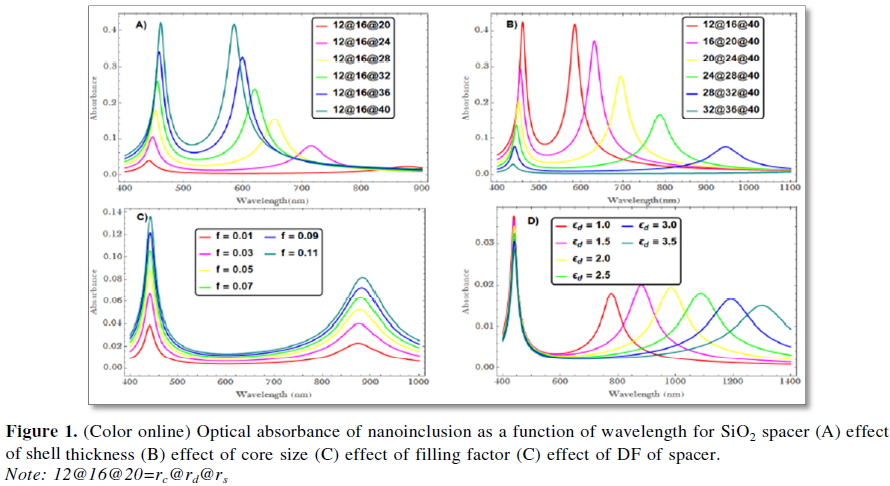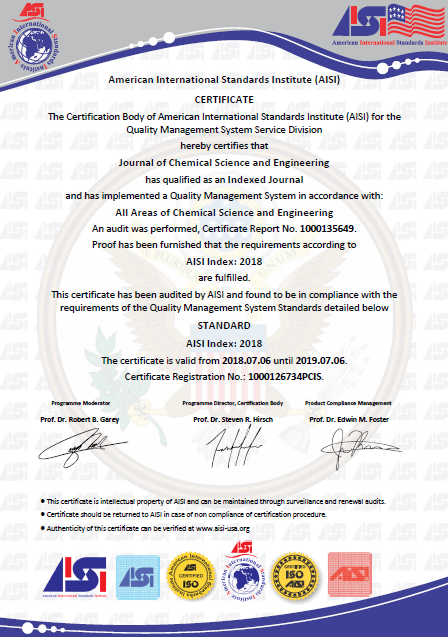617
Views & Citations10
Likes & Shares
In this mini review, the effect of parameters on the optical properties
of triple layered core-shell nanostructure is addressed. Optical absorbance of
cylindrical triple layered core-shell nanoparticles are analyzed based on
quasi-statics approximation of classical electrodynamics which is embedded in
the active host-medium. In this geometry, two set of plasmonic resonance are
observed: in visible region associated with inner interface of gold
(spacer@gold) and near/in infrared spectral region associated with outer
interface of gold (gold@medium). Optical response of the system, depend on the
core size, dielectrics function and thickness of spacer, shell thickness, size
of the composite, filling factor, and dielectrics function of host-medium. By optimizing
materials parameter to the ‘desired’ values, such type of composite which are
highly enhanced and tuned, are recommended for various applications like senor,
photocatalysis, biomedical, nano-optoelectronics.
Keywords: Core-shell, Spacer, Host-medium, Filling
factor, Enhancement factor, Dielectrics function
INTRODUCTION
Core-shell nanoparticles (CSNPs) consist of
one core and one or more than one shell nanomaterial by using encapsulation
process in different geometry and size to obtain new materials with combined
and/or other unique properties neither shown by constituents [1]. CSNPs can be
consisting from metal, semiconductor, dielectrics or organic/inorganic
materials one is a core and another or the same material is a shell [2,3].
Among core-shell nanostructures, metallic shell nanoparticles have unique or
new properties. These new or unique properties mainly arise from the
interaction of metallic (plasmonic) shell materials with the electromagnetic
field which is greatly intensified by a phenomenon known as the Surface Plasmon
Resonance (SPR) and the interaction of Plasmon of the metallic shell with inner
materials [4].
Two layered core-shell nanostructure (CSNS) is
widely studied either experimentally or/and theoretically [1,5]. To fabricate
new or modify optical properties and application of two layered nanoparticle,
the best alternative is inserting a new material as a spacer. To the best of my
knowledge, Triple layered CSNS like ZnO@M@Au (M=vacuum, water, dielectrics,
semiconductor) is not further studied yet. In addition to this, the present
review provides a very conceptual framework, including specific cases
previously investigated. In such system, there is an interaction between
exciton-exciton/polariton-plasmon in the nanoinclusion which is very interested
for new properties and various applications.
THEORETICAL MODEL
Consider this triple
layered core-shell nanoparticle (NP) consisting of a semiconductor core (ZnO) of dielectric function εc, spacer (M) εd
and a metallic (Au) shell of DF εs embedded in a
non-absorptive host matrix having a real DF εm.
The radius of core, spacer and shell is rc,
rd and rs, respectively, in which
the volume fraction spacer to spacer+core and shell to composite is β1=1-(rc/rd)2
and β2=1-(rd/rs)2,
respectively. When the composite of triple layered CSNP is irradiated (placed
in) with an electromagnetic radiation, electric field is induced in the system
due to polarization.
This composite
(ensemble) has its own dielectrics function called effective dielectrics function
(εeff). The effective
dielectrics function of the system written as [3]:
εeff = εm[1
+ 3fα/(1 – fa)] (1)
known as
Maxwell-Garnett equation and where f
is the filling factor which tell us how much the array of composite is embedded
in the host- medium and α is the polarizability of
composite.
Some of the metal
properties, including optical properties can be described with the simple
free-electron gas Drude-Sommerfeld model of dielectric function. In the
framework of this model, by applying an external field, the conduction
electrons move freely between independent collisions occurring at the average
rate of the frequency dependent dielectric function ε(ω, reff) predicted by the Drude-Sommerfeld model
[8,12,13].
![]()
ω2 + iω (γbulk + A νF/reff)
where ε∞ is the phenomenological
parameter describing the contribution of bound electrons to polarizability, ωp is the bulk
plasmon frequency, γbulk
is the damping constant of the bulk material, νF is the electron velocity at the Fermi surface, A=0.25 [8] is an empirical parameter.
For Au, ε∞=9.84, γbulk=0.072 eV and ωp=9.02 eV [12], νF=1.38
M m/s [14].
reff is the effective
mean free path of collisions, i.e., determines the broadness of Plasmon
resonance and can be calculated from [8,14],
reff = 0.5[(rs
− rd)(r2 − r2)]1/3 (3)
RESULTS AND DISCUSSION
Optical properties of
matter are a consequence of reflect, transmit and absorb of coming light. In
many optical problems, the complex refractive index of material is the basic
parameter. The refractive index of the medium related to its dielectrics
function which describes the electronic interaction of the medium with incident
light wave of frequency. The response of a medium to an incident light wave may
be described by a complex refractive index (n˜) which for a nonmagnetic medium
is expressed as:
n˜ = √ (εeff) (4)
Incident light, in
general, propagating in the composite is attenuated both by absorption and by
scattering [15]. However, for NPs that are much smaller than the wavelength of
incident light, scattering effects may be neglected so that only the absorption
significant to the attenuation. By considering this phenomenon into account, this
review paper focused on optical absorbance of nanoinclusion by optimizing the
parameters. It brushed up one of author’s research work [3] by incorporating
new investigations.
Figure 1, depicts optical
absorption of triple layered CSNS as a function of wavelength by using Eq. 4
for different parameters: filling factor, DF of spacer and host medium, core
size, shell thickness. Figure 1A depicts the optical absorbance of
quantum wire by increasing shell thickness (i.e., the shell concentration is
36.00%, 55.56%, 67.35%, 75.00%, 80.25% and 84.00%) and the other parameters is
kept constant (i.e., f=0.01, εm=2.25, β1=0.44). As shown in the figure, the optical absorbance
is increased and the two peaks are closed each other when the shell thickness
increasing. Similarly, the optical response of quantum wire CS is illustrated
in Figure 1B by increasing the core size from 12 nm to 32 nm with the
range of 4 nm for a fixed spacer and shell thickness. When the core size
increased, correspondingly the shell concentration is decreased (i.e., 84.00%,
75.00%, 64.00%, 51.00%, 36.00% and 19.00%). As shell concentration decreased,
the two interface resonances are decreased and but the second resonance is
shifted to IR spectral region. For the concentration of metallic shell arranged
to 19%, the outer interface resonance located at 13000 nm wavelength. In this
resonance, the red shift of the absorption edge represented the change in the
nanoparticles energy gap. It means that since the band gap of semiconductor
materials will increase with the decrease in particle size, the so-called
quantum size effect, it leads to the shift of the absorption edge towards high
energy [9].
The optical
absorbance of the given composite is also depending on the number of array
embedded in the given matrix. To clarify this effect, the effect of filling
factor is illustrated in Figure 1C for a fixed spacer and shell
concentration 43.75% and 36.00%, respectively. As shown in the figure, when the
filling factor is increased the optical absorbance of the composite is enhanced
without shifting the peaks position. In addition to the above parameters, the
optical absorbance of nanoinclusion is affected by DF of hot matrix and spacer.
In the Figure 1D, I tried to explain the effect of spacer’s DF. The
intensity of both interface’s resonance are decreased when DF of spacer increasing
but the second resonance is shifted to higher wavelength. The first resonance
of quantum wire CS is decreased when the dielectrics function of the spacer
increasing. These resonances may be attributed to near band edge absorption
(NBA) due to free exciton recombination. As discussed by Kassahun [3], both
interface resonances are decreased when the spacer thickness increasing for a fixed
core size and shell thickness.
The resonance peak
for a single ZnO and Au nanoparticle is exist at visible region [16], but by
combining them and by sandwiching other materials between them for the same
size, the absorbance is enhanced and shifted to IR region that is interested
phenomena for biological, photocatalysis and other various application.
CONCLUSION
In this mini review
paper, the effect of parameters: core size, shell thickness, DF of spacer,
filling factor and size of composite on the optical absorbance of Zn@M@Au
(m=spacer) quantum wire CS is addressed. By optimizing these and other
parameters (not mentioned here), the optical response of nanoinclusion is
enhanced and highly tuned and can be used for different applications. The
enhancement in the optical properties is mainly attributed to strong coupling
of the surface plasmon resonance of the Au shell and the energy gap of the
inner part NPs, interaction of exciton-exciton/polariton-plasmon of the
composite and interaction of the composite with it environment. Note that the
results show triple layered core-shell nanostructures are composed of a
semiconductor core of ZnO coated by thin Au NP with different spacer material
can be ideal candidate for enhancing biological, solar-cell, catalysis
application. Important remark can be pulled in this theoretical work, ZnO@M@Au core-shell
nanostructures with large core absorbed more light.
ACKNOWLEDGEMENT
This work is
supported by Adama Science and Technology University (ASTU).
1. Bartosewicz
B, Michalska-Domańska M, Liszewska M, Zasada D, Jankiewicz BJ (2017) Synthesis
and characterization of noble metal titania core-shell nanostructures with
tunable shell thickness. Beilstein J Nanotechnol 8: 2083-2093.
2. Senthilkumar
N, Ganapathy M, Arulraj A, Meena M, Vimalan M, et al. (2018) Two step synthesis
of ZnO/Ag and ZnO/Au core/shell nanocomposites: Structural, optical and
electrical property analysis. J Alloys Compd 750: 171-181.
3. Kassahun
GB (2019) High tunability of size dependent optical properties of ZnO@M@Au
(M=SiO2, In2O3, TiO2)
core/spacer/shell nanostructure. Adv Nano Res 2: 1-13.
4. Encina
ER, Prez MA, Coronado EA (2013) Au@ZnO hybrid nanostructures: Correlation
between morphology and optical response J Nanoparticle Res 15: 1688.
5. Mu¨ller
A, Peglow S, Karnahl M, Kruth A, Junge H, et al. (2018) Morphology, optical
properties and photocatalytic activity of photo- and plasma-deposited Au and
Au/Ag core/shell nanoparticles on titania layers. Nanomaterials 502: 6-12.
6. Zhou
M, Diao K, Zhang J, Wu W (2014) Controllable synthesis of plasmonic ZnO/Au
core/shell nanocable arrays on ITO glass. Nanostructures 56: 59-63.
7. Daneshfar
N, Bazyari K (2014) Optical and spectral tunability of multilayer spherical and
cylindrical nanoshells. Appl Phys A Mater Sci Process 116: 611-620.
8. Beyene
G, Senbeta T, Mesfin B (2019) Size dependent optical properties of ZnO@ Ag
core/shell nanostructures. Chinese J Phys 58: 235-243.
9. Singh
SC, Swarnkar RK, Gopal R (2010) Zn/ZnO core/shell nanoparticles synthesized by
laser ablation in aqueous environment: Optical and structural
characterizations. Bull Mater Sci 33: 21-26.
10. Brijitta
J, Ramachandran D, Chennakesavulu K, Bera S, Rabel AM, et al. (2016) Mesoporous
ZnO-SiO2 core-shell rods for UV absorbing and non-wetting applications
Mater Res Express 3: 25001.
11. Azimi
M, Sadjadi MS, Farhadyar N (2016) Fabrication and characterization of
core/shell ZnO/gold nanostructures and study of their structural and optical
properties. Orient J Chem 32: 2517-2523.
12. Derkachova
A, Kolwas K, Demchenko I (2016) Dielectric function for gold in plasmonics
applications: size dependence of Plasmon resonance frequencies and damping
rates for nanospheres. Plasmonics 11: 941-951.
13. Chettiar UK, Engheta N (2012) The design and
simulated performance of a coated nano-particle laser. Opt Express 20:
22976-22986.
14. Lv W,
Phelan PE, Swaminathan R, Otanicar TP, Taylor RA (2012) Multifunctional
core-shell nanoparticle suspensions for efficient absorption. J Sol Energy Eng
135: 021004.
15. Bijanzadeh
AR, Vakili MR, Khordad R (2012) A study of the surface Plasmon absorption band
for nanoparticles. Int J Phys Sci 7:1943-1948.
16. Sambou
A, Ngom BD, Gomis L, Beye AC (2016) Turnability of the plasmonic response of
the gold nanoparticles in infrared region. Am J Nanomater 4: 63-69.



